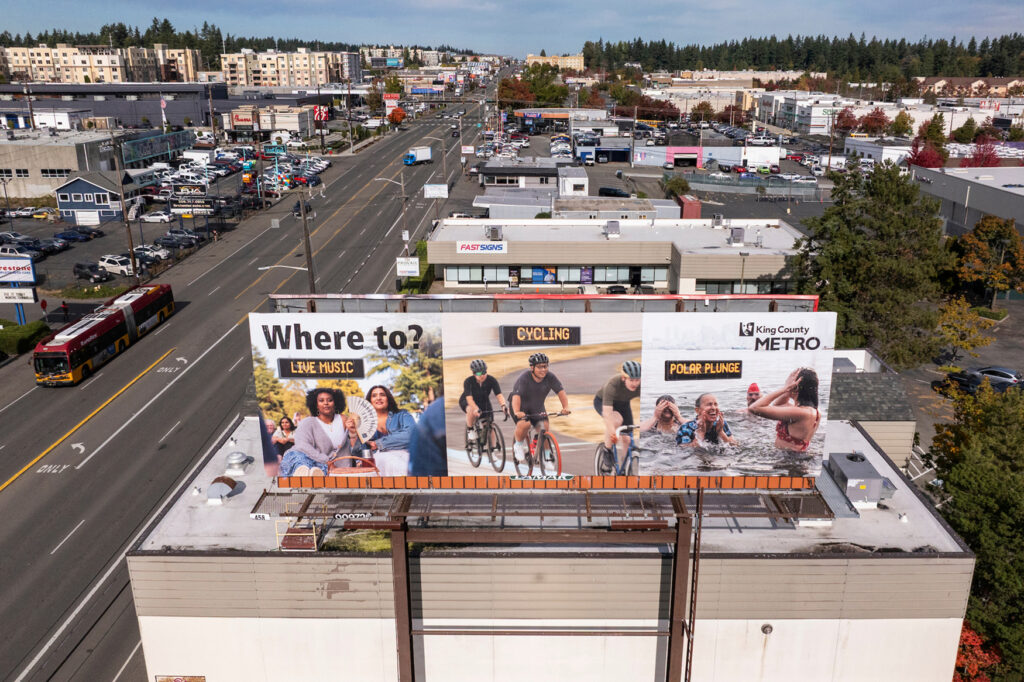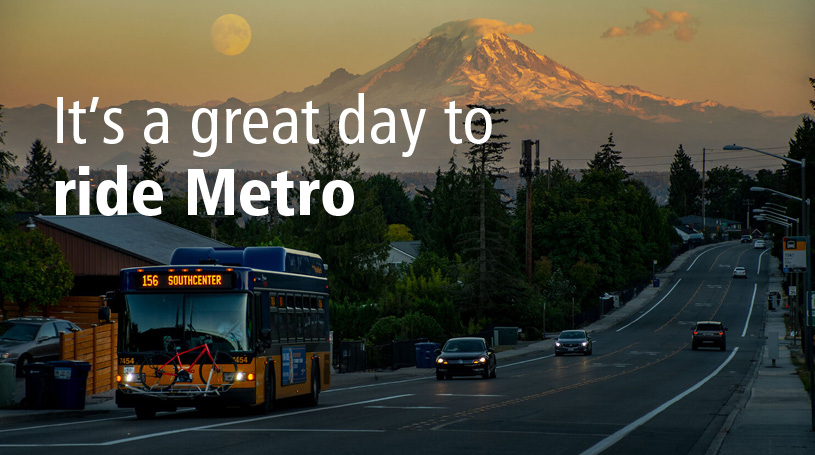It’s the Journey and the Destination
By Sean Hawks | 10/30/2025
SEAN HAWKS
Director of Communications and Marketing
King County Metro
Seattle, WA

While I lead transit communications and marketing in Washington state, my earliest public transportation journeys were nearly 5,000 miles away in my birthplace of London, England.
As a toddler, my paternal grandmother—who exclusively took transit or walked—would take my sister and me on double-decker buses. I’d always ask to go upstairs. But my Granny, to avoid taking two small children up and down a windy staircase on a moving vehicle, creatively claimed that we couldn’t go up there because that’s where the bus driver lives.
It was only when my dad’s cousin assumed babysitting duties one day and—not knowing the convenient white lie—let us go upstairs on the bus that the truth was revealed. I could finally sit upstairs—ideally in the front row—and pretend to drive, while seeing all around and far into the distance.
Credible Optimists
The ability to climb above what’s in our immediate vicinity and to share what’s ahead guides our communications at King County Metro. We do this while also remaining dedicated to delivering and improving upon accessibility, ease of travel, operations, reliability, and safety.
For at least the last five years and into the present, the challenges of the day—instability of funding, security, supply chain disruptions, travel pattern changes, workforce shortages, etc.—can threaten the internal resources and organizational confidence to develop and broadcast what the brighter future will look like. Counterintuitively though, difficult times are when communicating a long-term vision is most needed.
Even at the beginning of the pandemic, with the first U.S. death occurring in our state, Metro never took a minute off from serving our riders and we chose to communicate hopefulness despite uncertainty. “Right now seems endless, but it’s not forever,” we stated in a video at the time. Without dismissing fears, we calmly offered the facts on what we were doing and what customers could do, and gently extended an invitation to riders who had not yet returned to transit: “We’re ready when you are.”
As public optimism slowly recovered in the year that followed, we doubled down by launching “It’s a great day to ride Metro.” The campaign literally showed the beautiful promise of transit—through stunning sunrise photographs of Metro’s buses, vehicles, and vessels on their route surrounded by mountains, neighborhoods, and the Puget Sound.

The Best Way to Travel
We’re especially proud that Metro provides connections to education and jobs; reduces congestion and pollution; and unlocks opportunities for people with disabilities. But our communications goal is not to get people to ride and support transit because it’s the right thing to do, but because it’s their favorite way to travel. We’re critical infrastructure—like electricity, roads, and water—that delivers high-quality service to everyone. We can’t afford to be mistaken for a charitable enterprise that’s expendable when budgets are tight.
For two years in a row, Metro has boasted the second-fastest growing ridership in the nation. Supported by our transit-loving residents, we’ve added service, expanded evening and weekend options, and provided all-day connections throughout our county—not just the traditional morning and evening commutes to and from downtown. We simultaneously improved cleaning, security, and support for residents in need.
We touted these milestones through blog posts, events, interviews, op-eds, social media, videos, and more. However, we also know that overemphasizing our solutions can inadvertently elevate awareness of the initial problems. Even though broader societal issues—rather than transit—are at the root of the challenges we face, we must avoid inadvertently reinforcing negative associations that harm our reputation.
It’s important to maintain a separate, ongoing positive communications track that is carefree and fun. A few years ago, while recruiting bus drivers to reduce frustrations with cancelled trips, we also hosted a media event and invited TV news to cover our first pet-friendly water taxi sailings. A bus driver’s small dog named K.C.(King County) Metro stole the show.
We partner with the DubSea Fish Sticks, a beloved summer league baseball team whose stadium—“The Fryer”—is on one of our BRT lines. Their affordable, family-friendly experience includes the pitcher arriving at the mound in a golfcart decorated to look like our nearby RapidRide H Line bus. The team’s college-age players, many of whom grew up in the area, drive the Metro bus golfcart in parade appearances, and the mascot—“Fin Crispy Jr.”—appears in our videos.
More recently, we collaborated with local artists to design whimsical map-style playmats of our region. We’re distributing the beautiful, five-foot by seven-foot mats to daycares, libraries, pediatricians’ offices, preschools, and youth organizations so children can sit in the map with their toy vehicles and explore by rail, road, and water.

Beyond the Journey
Transit superfans aside—which admittedly there are more than I imagined, evidenced by fast sell-outs of themed transit cards and college students showing up to bid farewell to our last diesel bus—most Metro riders are primarily seeking a solution to a transportation problem. As such, our messaging and visuals show frequent, reliable service; a safe and welcoming atmosphere; and a clean and comfortable ride. But we’re also increasingly highlighting the reason you got on board in the first place: the people and places at the end of your journey.
Our “Grow with Metro” and “Where to?” campaigns showed the individual aspirations behind the 1.8 million trips that Metro delivers each week. “Grow with Metro” depicted customers taking transit to try something new: adventuring outdoors, taking a pottery class, and a granddaughter and grandfather cheering on Seattle’s recently founded National Hockey League team: the Kraken. Then, in a nod to the destination signs on the front of buses, “Where to?” shows each rider’s personal destination floating above their head thanks to special effects. We see various friends uniting for bicycling, live music, and a polar plunge.
To reach youth, our “Go all the places. Do all the things.” and “Escape the scroll” efforts encouraged young people to embrace the freedom and real-life possibilities of transit. In “Escape the scroll,” their transit card magically beams youth from the boredom of their phones to making friends at an arcade, the aquarium, a movie theater, a roller rink, and a soccer game.
In strategic communications, it’s our responsibility to add context and values when challenges arise, and our privilege to share the remarkable stories of our customers and colleagues along the way. But it’s often most rewarding to paint the vision of what’s ahead.